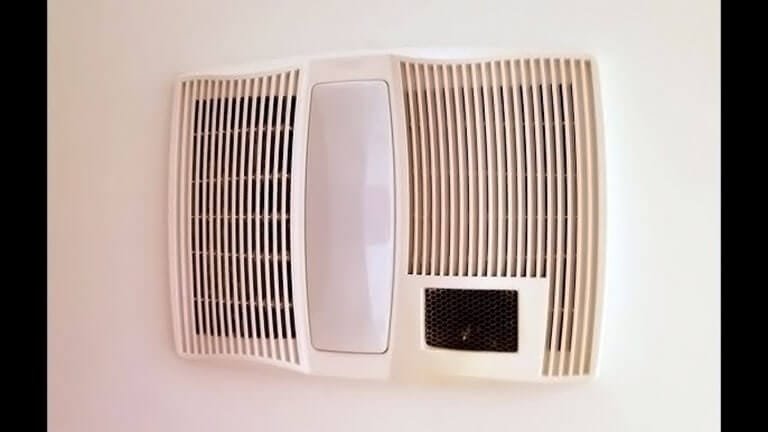Imagine stepping into your bathroom on a chilly morning, hoping for a warm and cozy experience, only to find that your bathroom fan heater isn’t working. Frustrating, right?
When your bathroom fan heater fails, it can disrupt your daily routine and leave you shivering. But before you start worrying about costly repairs or replacements, let’s explore some potential reasons why your bathroom fan heater might not be working.
Understanding these causes can save you time, money, and a lot of stress. Ready to uncover the mystery and get your bathroom back to its warm, inviting self? Keep reading to find out what might be going wrong and how you can fix it.
Common Causes Of Malfunction
Bathroom fan heaters often stop working due to clogged filters or blocked vents. Loose wiring can disrupt power supply. Overheating issues may stem from excessive dust accumulation, causing the unit to shut down for safety. Regular maintenance can help prevent these common problems and ensure efficient operation.
When you step into your bathroom on a chilly morning, the last thing you want is a bathroom fan heater that refuses to work. Understanding the common causes of malfunction can help you troubleshoot and potentially fix the issue yourself. Whether you’re a DIY enthusiast or just someone trying to keep warm, knowing these causes can save you time and frustration.
Power Supply Issues
Often, the root of the problem lies in something as simple as the power supply. Check if the heater is plugged in properly. Sometimes, a loose plug can be the culprit, cutting off the power flow. Ensure that the outlet is functioning by testing it with another device. If the outlet isn’t working, you might need to reset the circuit breaker. It’s astonishing how many times a simple power check resolves the issue.
Faulty Wiring
Faulty wiring can be more complex but is a common issue in older homes. Wires can degrade over time, leading to poor connections or shorts. If you notice any flickering lights or intermittent power, it might be a sign of faulty wiring. You can inspect the wiring visually, but remember to turn off the power before doing so. If you’re not confident, calling a professional might be the safest route. It’s crucial not to overlook this issue as it can lead to bigger problems down the line.
Blown Fuse
A blown fuse is another frequent cause of a non-working bathroom fan heater. Check your fuse box to see if any fuses have tripped. A blown fuse can occur if your heater draws more power than your electrical system can handle. Replacing a fuse is a straightforward task. Ensure you replace it with one that matches the amperage rating of the old one. Have you considered keeping spare fuses at home? They can be lifesavers in moments like these. Understanding these common causes not only helps you fix the problem but also empowers you to maintain your home better. Next time your bathroom fan heater acts up, you’ll know exactly where to start looking!
Checking Power Supply
When your bathroom fan heater stops working, the power supply is the first thing to check. Many issues stem from electrical problems. Ensuring the fan receives power can save time and money.
Inspecting Circuit Breaker
Sometimes, a tripped circuit breaker causes the fan to stop working. Locate your home’s electrical panel. Find the switch labeled for the bathroom or specific fan. If the switch is in the off position, flip it back on. Listen for clicks or feel for resistance, indicating a reset.
If the breaker trips again, there may be an underlying issue. You might need a professional electrician. Check for signs of wear or burnt odor near the panel. Safety is a priority when dealing with electricity.
Testing Power Outlet
The power outlet might be faulty. Unplug the fan heater and plug in another device. If the device works, the outlet is fine. If it doesn’t, the outlet may need repair. This simple test can identify outlet issues quickly.
Inspect the outlet for visible damage. Cracks or burns indicate serious problems. Avoid using damaged outlets to prevent hazards. Consider using a multimeter for more precise testing. This tool measures voltage and ensures outlets function properly.
Examining Wiring Connections
If your bathroom fan heater suddenly stops working, you might be scratching your head wondering why. One common culprit could be the wiring connections. A thorough examination of the wiring can reveal issues that are easy to overlook but crucial for your heater’s performance. You don’t need to be an electrician to tackle this; with a bit of guidance, you can identify and correct wiring issues yourself. Let’s dive into the specifics.
Identifying Loose Wires
Loose wires are often the reason behind a non-functional bathroom fan heater. Inspect the wiring connections carefully. Are any wires visibly disconnected or dangling? This might be your problem.
Imagine pulling out a tangled mess of holiday lights only to find half the strand dark. It’s frustrating, right? The same goes for your heater. Loose wires break the circuit, stopping electricity from flowing as it should. Use a flashlight and a screwdriver to check and tighten any loose connections.
Correcting Wire Connections
Once you’ve identified loose wires, the next step is correcting them. Ensure each wire is securely connected to the terminal. If a wire seems damaged, replace it with a new one.
When was the last time you fixed something yourself? It’s empowering, right? Correcting wire connections is similar. You’ll need to unscrew the terminal, slip the wire in, and tighten the screw. It’s simple yet effective.
Consider this: if your heater worked perfectly after fixing the wires, what else could you tackle next? The process builds confidence and encourages DIY maintenance. Don’t hesitate to consult your heater’s manual for guidance or call a professional if you’re unsure.
By addressing wiring issues, you not only resolve the immediate problem but also extend the lifespan of your heater. Are you ready to give it a try and see if your heater springs back to life?
Replacing Blown Fuses
If your bathroom fan heater stops working, a blown fuse might be the cause. Replacing it can solve the problem quickly. But, knowing where to start is crucial. This guide walks you through the process.
Locating The Fuse Box
First, find your home’s fuse box. It’s often located in a utility room or basement. Sometimes, it’s in a garage or hallway. Open the box carefully. Use a flashlight if it’s dark. Look for labels that indicate different circuits. These labels help you identify the right one for the bathroom.
Choosing The Right Fuse
Next, select the correct fuse for replacement. Check the blown fuse’s amperage. The amperage is marked on the fuse itself. Choose a new fuse with the same amperage rating. This ensures safety and proper function. Always keep spare fuses at home. This makes future replacements easier and faster.
Why Bathroom Fan Heater is Not Working [Here is Cleaning The Fan Heater]

Keeping your bathroom fan heater clean is crucial for its efficiency. Dust and dirt can cause poor performance. Regular cleaning prevents these issues. It ensures your heater works effectively. Below, explore the steps for cleaning your fan heater. This will help you maintain a warm bathroom.
Removing Dust Buildup
Dust buildup is a common problem in fan heaters. It can block airflow and reduce efficiency. First, unplug the heater for safety. Remove the cover carefully. Use a soft brush or cloth to wipe away dust. Be gentle to avoid damaging parts. For stubborn dust, use a vacuum with a brush attachment. This ensures thorough cleaning.
After cleaning, check for any hidden dust. Clean the fan blades with care. Dust-free blades spin better. This helps the heater function properly. Regular dust removal keeps your heater in top shape.
Maintaining Airflow
Proper airflow is essential for your heater. Check the vent openings for blockages. Clear away any obstructions. Ensure the vents are open and unobstructed. Good airflow allows the heater to distribute heat evenly.
Inspect the fan motor for dust or debris. Clean it gently if needed. A clean motor runs smoothly. This prevents overheating and prolongs the heater’s life. Regular maintenance keeps your bathroom warm and cozy.
Assessing The Motor Function
When a bathroom fan heater stops working, the motor is often the culprit. Assessing the motor function helps determine if it needs repair or replacement. A faulty motor can lead to ineffective heating or complete failure.
Understanding how to assess the motor can save time and money. Let’s explore the key steps to diagnose the motor’s condition.
Testing Motor Performance
Start by switching off the power supply. This ensures safety during inspection. Remove the fan cover to access the motor. Check for visible signs of damage or wear. Use a multimeter to test the motor’s electrical continuity. A lack of continuity suggests a broken motor.
Listen for unusual sounds when turning the motor manually. Grinding or squeaking noises indicate internal issues.
Lubricating Motor Parts
Lubrication helps maintain motor efficiency. Use a lightweight machine oil for lubrication. Apply a few drops to the motor’s bearings. This reduces friction and prolongs motor life.
Ensure not to over-lubricate, as this can attract dust. Regular lubrication can prevent future motor problems.
Consulting Professional Help
When your bathroom fan heater stops working, it can be frustrating. You may try basic troubleshooting steps. But sometimes, the issue requires expert knowledge. Consulting a professional can save you time and effort. They have the skills to identify and fix complex problems. This ensures your fan heater functions properly and safely.
When To Call An Electrician
If your fan heater doesn’t respond to simple fixes, call an electrician. Strange noises, burning smells, or frequent tripping breakers are warning signs. These could indicate serious electrical issues. Attempting to fix them yourself might be dangerous. An electrician can diagnose and address these problems safely.
Finding Reliable Service
Finding a reliable electrician is crucial. Check online reviews and ask for recommendations. Look for professionals with relevant experience and certifications. A reliable service provider will offer transparent pricing. They should also provide a guarantee for their work. This ensures peace of mind and quality repair.
Frequently Asked Questions
Why Is My Bathroom Fan Heater Not Turning On?
Check the power source. Ensure the heater is plugged in and the circuit breaker is not tripped.
Could The Fan Heater Be Clogged With Dust?
Yes, dust can block airflow. Clean the fan blades and vents to improve performance.
How Do I Know If The Heater’s Motor Is Broken?
Listen for unusual noises. If the heater hums or doesn’t start, the motor may be faulty.
Is My Bathroom Fan Heater Overheating?
Overheating can cause shutdowns. Check for blocked vents and ensure the thermostat is set correctly.
Can Electrical Wiring Issues Affect Fan Heater Performance?
Absolutely. Faulty wiring can prevent operation. Inspect connections or consult an electrician for help.
Conclusion
A malfunctioning bathroom fan heater can cause frustration. Regular checks prevent issues. Clean the fan to avoid dust buildup. Ensure all wires are secure. Listen for unusual noises. A small fix might restore functionality. Consider professional help if problems persist.
A functioning fan ensures comfort and safety. Regular maintenance extends the heater’s lifespan. Remember, small steps can prevent big problems. Stay proactive and enjoy a warm bathroom.
